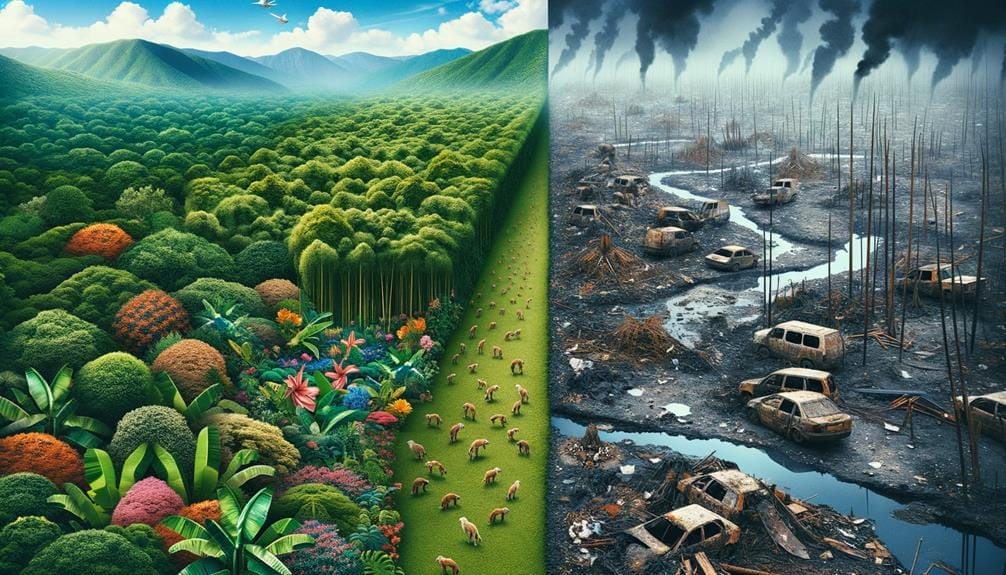Did you know that the use of epoxy resin in various industries, such as construction, art, and manufacturing, can have a significant environmental impact? While epoxy resin offers many benefits, such as its strong adhesive properties and versatility, it also raises concerns regarding its production processes, ecological effects, and impact on wildlife and human health.
Understanding the environmental consequences of epoxy resin is crucial for making informed decisions and exploring sustainable alternatives. So, what exactly are the environmental implications of using epoxy resin, and how can we minimize its negative effects?
Let's explore this topic further and discover ways to mitigate its environmental impact.
Key Takeaways
- Epoxy resin production and manufacturing processes contribute to harmful fumes and use chemicals that can contaminate water sources and contribute to air pollution.
- The ecological effects of epoxy resin include chemical leaching into the ground and water, disruption of natural balance, contamination of soil and water sources, habitat destruction, and altered nutrient cycles.
- Wildlife and marine life are impacted by epoxy resin through chemical leaching, posing a threat to various organisms, as well as the emission of harmful fumes during application or heating. The use of green resin alternatives and proper disposal and recycling methods can help prevent chemical entry into habitats and waterways.
- Epoxy resin poses human health concerns, such as the release of harmful fumes, potential for skin allergies, and the presence of carcinogenic ingredients in older epoxy resins. Proper ventilation, respiratory protection, and the use of protective gear and proper disposal methods are necessary to mitigate these risks.
Production and Manufacturing Processes
During the production and manufacturing processes of epoxy resin, harmful fumes are emitted and chemicals like Bisphenol-A (BPA) and epichlorohydrin (ECH) are used, which can have environmental impacts.
Epoxy resin is derived from petroleum products, making it an energy-intensive and environmentally taxing process. The production of epoxy resin involves the use of chemicals such as BPA and ECH, which have been linked to various environmental concerns.
BPA, a key component in epoxy resin, is known to have endocrine-disrupting properties and can contaminate water sources when not properly managed. ECH, on the other hand, is a potential carcinogen and can contribute to air pollution if not properly controlled during the manufacturing process.
Additionally, the energy-intensive nature of epoxy resin production contributes to greenhouse gas emissions and further exacerbates climate change.
To minimize the environmental impact of epoxy resin production, measures can be taken such as using low-emitting resins and ensuring proper ventilation to reduce the release of harmful fumes. Responsible disposal of unused resin and recycling efforts can also help mitigate the environmental impact associated with epoxy resin manufacturing.
Ecological Effects and Ecosystem Disruption
The harmful fumes emitted by epoxy resin during application or heating pose risks to both people and the environment, including ecological effects and disruption to ecosystems. When epoxy resin is used, chemicals can leach into the ground and water, leading to ecosystem disruption and harm to wildlife. To minimize these effects, it is crucial to use environmentally friendly resins that emit fewer harmful substances. Additionally, proper ventilation during the application process can help reduce the release of fumes into the environment.
Improper disposal of epoxy resin can also have detrimental ecological effects. When epoxy resin is not disposed of responsibly, it can contaminate soil and water sources, further endangering ecosystems and potentially harming wildlife. In order to mitigate these risks, it is important to handle and dispose of epoxy resin in accordance with proper practices and regulations.
The table below highlights the ecological effects and ecosystem disruption caused by epoxy resin:
| Ecological Effects of Epoxy Resin | Ecosystem Disruption | Harm to Wildlife |
|---|---|---|
| Chemical leaching into ground and water | Contamination and pollution | Endangered species |
| Disruption of natural balance | Habitat destruction | Reduced biodiversity |
| Contaminated soil and water sources | Altered nutrient cycles | Negative impact on food chains |
It is essential to address these ecological effects and take necessary measures to minimize the harm caused by epoxy resin on the environment and its ecosystems.
Wildlife and Marine Life Impacts

Wildlife and marine life can be significantly affected by the impact of epoxy resin on the environment. Epoxy resins can leach chemicals into the ground and water, posing a threat to various organisms. When not handled or disposed of properly, epoxy resin can pose a danger to animals and aquatic ecosystems. The fumes emitted during the application or heating of epoxy resin can also harm wildlife and marine life. It's crucial to ensure proper ventilation when working with epoxy resin to minimize the exposure of animals to these harmful fumes.
To mitigate the impact on wildlife and marine life, it's essential to consider using green resin alternatives that have minimal environmental impact. These resins are designed to be more sustainable and less harmful to ecosystems. Additionally, proper disposal and recycling of epoxy resin can help prevent its chemicals from entering natural habitats and waterways.
Furthermore, incorporating plant-based materials into epoxy resins can reduce their environmental impact. By using plant matter as a substitute for some of the petroleum-based ingredients, the overall carbon footprint of epoxy resins can be reduced. This not only benefits the environment but also helps protect wildlife and marine life from potential harm.
Human Health Concerns
Exposure to epoxy resin can pose various health risks to individuals, including the release of harmful fumes and the potential for skin allergies. It's important to be aware of these risks and take appropriate precautions when working with epoxy resin.
Here are a few key points to keep in mind:
- Harmful fumes: Epoxy resin can release volatile organic compounds (VOCs) during application or when heated. These fumes can irritate the respiratory system and may even be toxic in high concentrations. It's essential to work in a well-ventilated area or use respiratory protection to minimize exposure.
- Skin allergies: Contact with epoxy resin on the skin can cause allergic reactions, such as dermatitis. It's crucial to wear protective gloves and clothing to prevent direct contact with the resin. If skin irritation occurs, immediate removal of the resin and washing the affected area with soap and water is recommended.
- Carcinogenic ingredients: Older epoxy resins may contain carcinogenic ingredients, such as bisphenol A (BPA). Prolonged exposure to these substances can increase the risk of developing certain cancers. Therefore, it's advisable to use epoxy resins that are free from harmful additives and to follow proper disposal methods to minimize environmental contamination.
Taking these precautions, such as ensuring proper ventilation, using protective gear, and responsible disposal, can help mitigate the health risks associated with epoxy resin use, safeguarding both individuals and the environment.
Sustainable Alternatives and Mitigation Strategies

To address the environmental impact of epoxy resin, it's important to explore sustainable alternatives and implement mitigation strategies.
One approach is to use low-emitting resins and ensure proper ventilation when working with epoxy to minimize its environmental impact. By doing so, you can reduce the release of harmful volatile organic compounds (VOCs) into the atmosphere.
Another option is to explore the market for green or eco-friendly epoxy resin alternatives. These alternatives are often made from renewable resources or have a lower carbon footprint compared to traditional petroleum-based epoxy resins. However, it's crucial to educate yourself about the environmental impact of epoxy resin made from petroleum and be wary of greenwashing in the chemical industry.
Additionally, reusing or repurposing woodwork can help minimize the unnecessary disposal of epoxy resin and reduce its environmental impact.
Finally, proper handling and disposal of epoxy resin are essential to prevent contamination of water sources and ecosystems.
Frequently Asked Questions
Is There an Eco-Friendly Epoxy Resin?
Yes, there are eco-friendly epoxy resin options available. These sustainable alternatives help reduce your carbon footprint and often come with environmental certifications, ensuring a more environmentally conscious choice for your projects.
Is Epoxy Coating Eco-Friendly?
No, epoxy coating is not eco-friendly. Sustainable alternatives exist, and a lifecycle analysis of epoxy resin production reveals its negative environmental impact. Environmental regulations are necessary to regulate epoxy resin usage and minimize harm.
What Is the Major Disadvantages of Epoxy Resin?
The major disadvantages of epoxy resin are its toxicity concerns, long curing time, and limited color options. It's like being stuck in a slow, toxic maze with limited choices for escape.
How Hazardous Is Epoxy Resin?
Epoxy resin can be hazardous due to its harmful fumes and potential leaching of chemicals. Proper disposal methods, adherence to environmental regulations, and awareness of its health effects are crucial for minimizing its impact.
Conclusion
You may be surprised to learn that epoxy resin production releases over 500,000 tons of greenhouse gases annually. This staggering statistic highlights the significant environmental impact of epoxy resin and the urgent need for more sustainable alternatives.
By exploring and adopting eco-friendly materials for art projects, we can protect ecosystems, wildlife, and our own health. Let's make conscious choices to minimize our contribution to this harmful industry and create a brighter, greener future for our planet.





